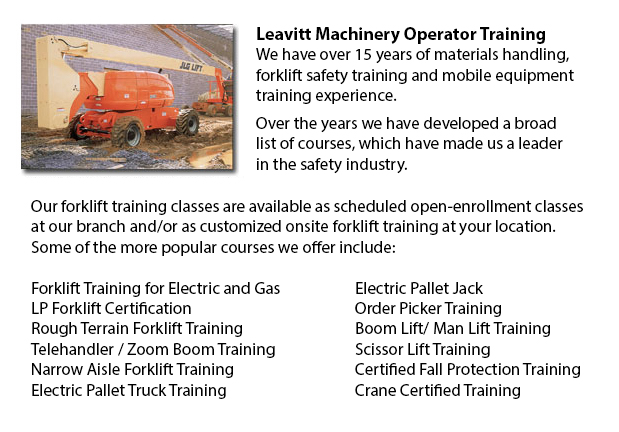
Manlift Training Edmonton - Various manlift training courses consist of the content and review of manlift devices. An important portion of the course is the practicum where students show their practical ability and knowledge to operate the manlift safely. A prerequisite to Manlift training is the fall protection training, that may be included in the training according to the particular requirements of the client.
Course Content
The program includes the following areas of instruction: pre-shift equipment inspection and work area survey requirements; the impact of doing unsafe acts or operating unsafe equipment, Review of load capacities, Lifting devise equipment definitions, the specific equipment requirements and safety decals, Review of related parts of the CSA Standards as well as the OHSA Standards and Review site particular Dangers, together with controls for safely using a lifting device.
Demonstration and Evaluation Content
The demonstration and evaluation portion of the course consists of: Proper personal protective equipment or also known as P.P.E. as required; Using a signaler or a spotter when required; using a lift only on level and solid ground; Utilizing the right fitting harness or fall arrest device; Operating the lift with all other employees clear of the job place; Aware of load limitations etc. and other specs as set out by the manufacturer; Having all associated machinery safely stored on the lift platform; Pre-shift work area survey and equipment check; Isolating off the work area when major work projects are to be done; and ensuring a safe and smooth operating speed for various plant conditions
Each of the trainees will undergo testing to make certain that they are able to safely operate their machine.
Manlift Safety
As the manlift is capable of lifting materials and personnel over 20 feet in the air, these equipment pose a particular amount of risk and could be dangerous machines if not operated properly. Since the danger is so apparent, lift operators and owners are careful to properly maintain their equipment and follow proper operating procedures and safety measures. The ratio of accidents involving this particular machinery is quite low.
The safety specifications for scissor lifts and boom lifts puts the burden for safe manlift operation on the user. You are responsible for understanding how to safely utilize the lift even if you just lease the equipment for a day. The most basic safety features on the machinery are the operating handbook and safety decals. These show important information regarding the maintenance, operating procedures and safety equipment.
Newer lift models will come together with manuals and decals in place. Technically, the operating manual must be kept on the lift itself. If you are purchasing a used lift, it is essential to ensure that the guidebook is included and that vital decals haven't been painted over. The restraints which prevent operators from falling and the guardrails are other vital safety features. These are mandatory and standard on all kinds of lifts.
-
Forklift Training Programs Edmonton
Forklift Training Programs Edmonton - If you are searching for work as an operator of a forklift, our regulatory-compliant lift truck training programs provide excellent instruction in numerous styles and types of forklifts, classes on pre-shift insp... More -
Heavy Equipment Training School Edmonton
Heavy Equipment Training School Edmonton - The heavy equipment operator courses will assist the operator in acquiring the required skills and knowledge they will require to be able to enter the workforce as an entry level operator. In this 12 week co... More -
Manlift Ticket Edmonton
Manlift Ticket Edmonton - The Elevated Platforms and Manlifts Certification program helps to provide the necessary training on the safe operating procedures, work practice, rules and regulations regarding the daily activities for the operators of thi... More -
Crane License Edmonton
Crane License Edmonton - Crane operators must be "credentialed", which means they must have a crane operator license or certification. Credentialing is considered a mandatory governmental requirement in order to practice as a crane operator. Having a... More -
Counterbalance Forklift License Edmonton
Counterbalance Forklift License Edmonton - When operated by totally trained operators, forklifts could become a major advantage for firms and companies. We could offer your staff a comprehensive training program which covers all aspects of operating... More -
Manlift Safety Training Edmonton
Manlift Safety Training Edmonton - Manlift operators have to be aware and cognizant of all the potential hazards which are associated with particular types of scissor lifts. They need to be able to operate the scissor lift in a way that protects not... More -
Forklift Training School Edmonton
Forklift Training School Edmonton - Forklift Training School And Reasons Why It Is Really Important - Industry and federal regulators have established the criteria for forklift safety training based on their existing standards and regulations. Indivi... More -
Overhead Crane Safety Training Edmonton
Overhead Crane Safety Training Edmonton - The overhead crane safety training course is designed to equip the operators with the right skills and knowledge in the areas of: crane safety precautions, materials handling, accident avoidance, and equipmen... More

Forklift Training Edmonton
crossorigin="anonymous">
TOLL FREE: 1-888-254-6157
Edmonton, Alberta
forklifttrainingedmonton.com
Email Us
About Us


